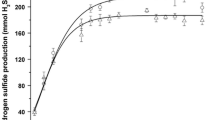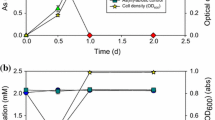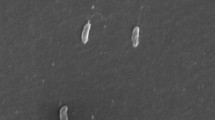Abstract
Arsenic (As) is a ubiquitous metalloid known for its adverse effects to human health. Microorganisms are also impacted by As toxicity, including methanogenic archaea, which can affect the performance of a process in which biological activity is required (i.e., stabilization of activated sludge in wastewater treatment plants). The novel ability of a mixed methanogenic granular sludge consortium to adapt to the inhibitory effect of arsenic As was investigated by exposing the culture to approximately 0.92 mM of arsenite (AsIII) for 160 days in an arsenate (AsV)-reducing bioreactor using ethanol as the electron donor. The results of shaken batch bioassays indicated that the original, unexposed sludge was severely inhibited by AsIII as evidenced by the low 50 % inhibition concentrations (IC50) determined, i.e., 19 and 90 μM AsIII for acetoclastic and hydrogenotrophic methanogenesis, respectively. The tolerance of the acetoclastic and hydrogenotrophic methanogens in the sludge to AsIII increased 47-fold (IC50 = 910 μM) and 12-fold (IC50 = 1100 μM), respectively, upon long-term exposure to As. In conclusion, the methanogenic community in the granular sludge demonstrated a considerable ability to adapt to the severe inhibitory effects of As after a prolonged exposure period.



Similar content being viewed by others
References
Ahmann, D., Roberts, A. L., Krumholz, L. R., & Morel, F. M. M. (1994). Microbe grows by reducing arsenic. Nature, 371(6500), 750–750.
APHA. (1999). Standard methods for the examination of water and wastewater. Washington D.C: APHA, AWWA and WEF.
ATSDR (2007) Toxicological profile for arsenic. U.S. Department of Health and Human Services, Public Health Service. Atlanta, GA.
Bini, E. (2010). Archaeal transformation of metals in the environment. FEMS Microbiology Ecology, 73(1), 1–16.
Cavalca, L., Corsini, A., Zaccheo, P., Andreoni, V., & Muyzer, G. (2013). Microbial transformations of arsenic: perspectives for biological removal of arsenic from water. Future Microbiology, 8(6), 753–768.
Cervantes, C., Ji, G., Ramírez, J. L., & Silver, S. (1994). Resistance to arsenic compounds in microorganisms. FEMS Microbiological Reviews, 15(4), 355–367.
Chen, Y., Cheng, J. J., & Creamer, K. S. (2008). Inhibition of anaerobic digestion process: a review. Bioresource Technology, 99(10), 4044–4064.
Ehrlich, H.L. (2002) Bacterial oxidation of As(III) compounds. Environmental Chemistry of Arsenic. William T. Frankenberger, J. (ed), pp. 313–327, CRC Press, New York, USA.
Fernandez, N., Diaz, E. E., Amils, R., & Sanz, J. L. (2008). Analysis of microbial community during biofilm development in an anaerobic wastewater treatment reactor. Microbial Ecology, 56(1), 121–132.
Field, J. A., Sierra-Alvarez, R., Cortinas, I., Feijoo, G., Moreira, M. T., Kopplin, M., & Gandolfi, A. J. (2004). Facile reduction of arsenate in methanogenic sludge. Biodegradation, 15(3), 185–196.
Giller, K. E., Witter, E., & McGrath, S. P. (1998). Toxicity of heavy metals to microorganisms and microbial processes in agricultural soils: a review. Soil Biology and Biochemical, 30(10–11), 1389–1414.
Kruger, M. C., Bertin, P. N., Heipieper, H. J., & Arsene-Ploetze, F. (2013). Bacterial metabolism of environmental arsenic-mechanisms and biotechnological applications. Applied Microbiology Biot, 97(9), 3827–3841.
Li, P., Wang, Y., Jiang, Z., Jiang, H., Li, B., Dong, H., & Wang, Y. (2013). Microbial diversity in high arsenic groundwater in Hetao Basin of Inner Mongolia, China. Geomicrobiol Journal, 30(10), 897–909.
Li, A., Luo, J., Xu, W., & Pan, T. (2015). Arsenic removal of high-arsenic wastewater from gallium arsenide semiconductor production by enhanced two-stage treatment. Desalination and Water Treatment, 55(5), 1285–1292.
Mandal, B. K., & Suzuki, K. T. (2002). Arsenic round the world: a review. Talanta, 58(1), 201–235.
O'day, P. A., Vlassopoulos, D., Root, R., & Rivera, N. (2004). The influence of sulfur and iron on dissolved arsenic concentrations in the shallow subsurface under changing redox conditions. Proceedings of the National Academy of Sciences of the United States of America, 101(38), 13703–13708.
Oremland, R. S., Hoeft, S. E., Santini, J. A., Bano, N., Hollibaugh, R. A., & Hollibaugh, J. T. (2002). Anaerobic oxidation of arsenite in Mono Lake water and by facultative, arsenite-oxidizing chemoautotroph, strain MLHE-1. Applied and Environmental Microbiology, 68(10), 4795–4802.
Oremland, R. S., Saltikov, C. W., Wolfe-Simon, F., & Stolz, J. F. (2009). Arsenic in the evolution of earth and extraterrestrial ecosystems. Geomicrobiology Journal, 26(7), 522–536.
Paikaray, S. (2015). Arsenic geochemistry of acid mine drainage. Mine Water and the Environment, 34(2), 181–196.
Rodriguez-Freire, L., Sierra-Alvarez, R., Root, R., Chorover, J., & Field, J. A. (2014). Biomineralization of arsenate to arsenic sulfides is greatly enhanced at mildly acidic conditions. Water Research, 66, 242–253.
Rodriguez-Freire, L., Moore, S.E., Sierra-Alvarez, R., Root, R.A., Chorover, J. and Field, J.A. (2015) Arsenic remediation by formation of arsenic sulfide minerals in a continuous anaerobic bioreactor. Biotechnol Bioeng, in press.
Rosen, B. P. (2002). Biochemistry of arsenic detoxification. Febs Letter, 529(1), 86–92.
Sierra-Alvarez, R., Cortinas, I., Yenal, U., & Field, J. A. (2004). Methanogenic inhibition by arsenic compounds. Applied and Environmental Microbiology, 70(9), 5688–5691.
Slyemi, D., & Bonnefoy, V. (2012). How prokaryotes deal with arsenic. Environmetal Microbiology Report, 4(6), 571–586.
Tchobanoglous, G., Burton, F. L., Stensel, H. D., & Metcalf and Eddy. (2003). Wastewater engineering: treatment and reuse. Boston, USA: McGraw-Hill Education.
Wang, P. P., Sun, G. X., & Zhu, Y. G. (2014). Identification and characterization of arsenite methyltransferase from an archaeon, Methanosarcina acetivorans C2A. Environmental Science and Technology, 48(21), 12706–12713.
Wang, Y. H., Li, P., Dai, X. Y., Zhang, R., Jiang, Z., Jiang, D. W., & Wang, Y. X. (2015). Abundance and diversity of methanogens: potential role in high arsenic groundwater in Hetao Plain of Inner Mongolia, China. Science of the Total Environment, 515–516, 153–161.
Yang, H. C., Fu, H. L., Lin, Y. F., & Rosen, B. P. (2012). Pathways of arsenic uptake and efflux. In S. Lutsenko & J. M. Arguello (Eds.), Metal transporters (Current topics in membranes, Vol. 69, pp. 325–358). San Diego: Elsevier Academic Press Inc.
Acknowledgments
This research was funded by a grant of the National Institute of Environment and Health Sciences-supported Superfund Research Program (NIH P42 ES-04940-11). Arsenic speciation analyses were performed by the Arizona Laboratory for Emerging Contaminants (ALEC) at the University of Arizona from our NIEHS-supported Superfund Research Program Grant#2. This work was partially funded by a Water Sustainability Program Fellowship, The University of Arizona, awarded to Lucia Rodriguez-Freire.
Author information
Authors and Affiliations
Corresponding author
Rights and permissions
About this article
Cite this article
Rodriguez-Freire, L., Moore, S.E., Sierra-Alvarez, R. et al. Adaptation of a Methanogenic Consortium to Arsenite Inhibition. Water Air Soil Pollut 226, 414 (2015). https://doi.org/10.1007/s11270-015-2672-3
Received:
Accepted:
Published:
DOI: https://doi.org/10.1007/s11270-015-2672-3




